Updated December 2003
In Europe and the US where wildfowl collections are relatively commonplace, hybrids are perhaps to be expected, but hybridization in wild ducks in East Asia (though not so well-documented) also appears to be fairly frequent. Sometimes parentage is obvious (examples include frequent wigeon hybrids and much more occasional Spot-billed Duck Anas poecilorhyncha X Mallard A. platyrhynchos hybrids), sometimes less certain.
This short note introduces a few photographs of three individuals which are presumed to be hybrid, and which might be of interest to resident and visiting birders. The note’s posting was prompted in the main by a note received from W. Duckworth on a Ferruginous Duck-type Aythya nyroca observed on the Taedong River in the 2001/2002 winter which later proved to be a hybrid, and by the observation in Busan of a bird suspected at long range of being a Baer’s Pochard Aythya baeri, in February 2003, until closer views showed it to also to be a hybrid.
American X Eurasian Wigeon
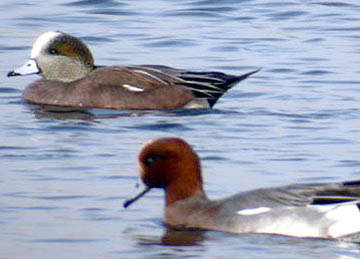
Photo © Nial Moores
This individual (photographed in November and December) can be aged as an adult (indicated by the white forewing) and in near-full breeding plumage, suggested by the uniform coloration of the breast and flanks. From some angles, the green head stripe was difficult to discern, while the white crown stripe also seemed rather short (and thus closer to Eurasian Wigeon (Anas) penelope than American Wigeon (A.) americana in length). In addition, the lower face appeared smooth, lacking the coarse darker speckling typical of American Wigeon, and grey-brown (with a hint of warmth at some angles) rather than grey. In addition, the mantle and several of the scapulars looked greyish toned, rather than tinged purpley or pink as in many American Wigeon. Are all such features within the range of American Wigeon or do they instead suggest hybrid influence?
Interestingly, the putative hybrid in 2002 did show many good American features sometimes considered very unusual in hybrids: its axillaries appeared white during wing-flaps, and there was a fairly clear dark band around the bill base.
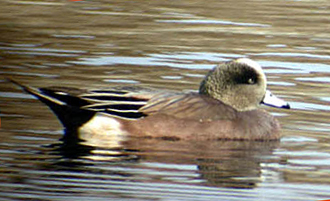
Photo © Nial Moores
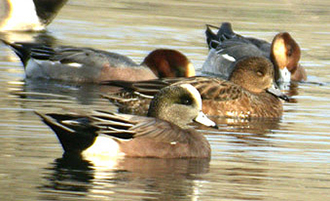
Photo © Nial Moores
Perhaps this is a second-generation hybrid?
Of further note is the observation that a significant percentage of Eurasian Wigeon drakes in East Asia show an obvious green patch near the eye as in the bird below, taken at the Nakdong Estuary in Dec 2003. Rarely this green patch extends across the whole head in a clearly-defined metallic green stripe, strongly suggestive of drake American Wigeon.

Some such individuals (possibly 1 in 10) show white crown stripes, grayish mottling on the lower face, or a richer purple-tone to the breast (rather than the pink-brick tone of typical Eurasian Wigeon), while others show several such features, appearing very close to American Wigeon, but with the green head stripe reduced or the head showing extensive brown admixed.
(Such presumed hybrid American X Eurasian Wigeon appear to be significantly more numerous than presumed pure birds in South Korea, with possibly 1 out of very approximately every 100 to 200 apparently pure Eurasian Wigeon showing some "odd" characters, and less than 3-5 "pure" American Wigeon recorded nationwide annually.)
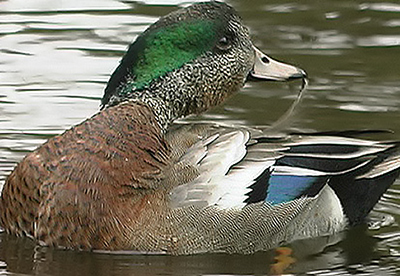
The colour of the feathering in this "patch/stripe" certainly appear to be a feature worth looking out for. An extreme example comes with an obvious hybrid American Wigeon x Mallard Anas platyrhynchos photographed in Vancouver, Canada (in March 2002). In this pairing the bird almost appears to be a drake American Wigeon from the neck up, and a drake Mallard from the neck down! WBKEnglish would be, as ever, pleased to hear from anyone engaged in research on the subject or with further examples.
For more photographs of this bird, go to Hybrid American Wigeon x Mallard photo-feature.
Hybrid Aythya: Feb 2003
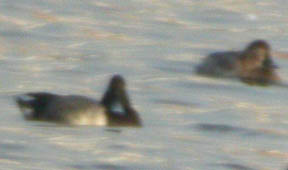
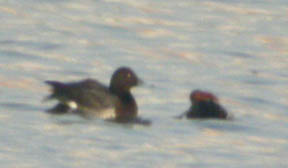
Common Pochard, Photo © Nial Moores
Scanning rafts of very distant Aythya at the Nakdong barrage in late February 2003, one bird looked rather good for a male Baer’s Pochard (a rare winter visitor/migrant in South Korea), showing an obviously darker head than the Common Pochard Aythya ferina it was with, obviously white undertail coverts, and a weak pale spur on the foreflanks. The main problem with identification as Baer’s, however, was the dull, greyish look to the flanks: not as striking as typical. Much closer views showed that the bird had obviously mixed characteristics, even though it was asleep with its bill tucked into the upperparts. Its head was rounded and quite well-peaked behind the eye, and showed obvious purple gloss, occasionally with a greener element. The upperparts were more solidly dark, like a Tufted DuckA. fuligula , but the flanks were grayish, becoming paler to the fore, with a whiteish spur apparent at some angles (suggestive of Ring-necked DuckA. collaris ), stretching up from an extensively white belly. The breast was washed with chestnut (like Baer’s), the flanks were grey, and the undertail coverts with white, framed with black. When the bird finally woke up and started to preen, it showed an obviously large, bluish bill, with a dark nail, and weakly demarcated pale subterminal area (good for Baer’s), a yellow eye (quite strongly coloured), and a striking wing pattern: white below, with white across the secondaries and perhaps inner primaries, and dark grey mid-to outer primaries. Considering the range of features it seems the bird was closest to Baer’s, with elements of Common Pochard, Tufted Duck (or even Ring-necked Duck and Lesser Scaup A. affinis!).
The record seems even more interesting considering the apparent pairing of a female-type Baer’s with a male Ferruginous Duck in South Korea in 2002 (see our New Species Paper), and the observation by Will Duckworth of an Aythya seen on the Taedong in the north between November 2001 and February 2002. Initially identified as a first winter male Ferruginous Duck (which would have predated the Joonam bird, making it a first for the Korean peninsula), it apparently started to molt "into a more informative stage" (Duckworth in lit.), revealing hybrid origin.
Gadwall X Falcated Duck or unknown Anas . Feb 2003 (Harike, Punjab, India)
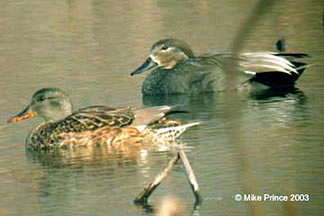
The three images above are from India and were kindly provided by Mike Prince.
They were originally posted at groups.yahoo.com/group/delhibird/files/Gadwall x Falcated Duck.
Although showing several hybrid features very strongly suggesting some Falcated Duck influence (" the sweep in the head-shape, the clear white fore-neck band and white at the bill base, features on Falcated but never on Gadwall. Unless there is much more variation in Gadwall than I have ever seen in 100,000s of birds I cannot see how there cannot be Falcated somewhere in this hybrid" : Bill Harvey, Delhi), without knowledge of the appearance of Falcated Duck x Gadwall offspring the parentage of this bird could also be considered, by the cautious, uncertain for now. A couple of the Falcated type features can be present on occasionally very well-marked Gadwall (in East Asia at least), such as strong chestnut and bronzed tones to the crown, and more obvious, longer, and paler falcations than typical. Although it shows the pale collar of Falcated, the bill seems rather large and heavy and the head pattern as depicted seems very dissimilar to Falcated Duck: the brown crown stripe for example does not reach the eye in Falcated Duck, while this greeny-brown stripe, with its lower pale border, in this bird does.

Photo © Mike Prince

Photo © Mike Prince
Whatever their origins, "wild" hybrids in East Asia (be they ducks, gulls or cranes, or even thrushes) appear to be both reasonably widespread and it seems generally under-reported.
As always, your opinions and further information/images much appreciated.
Additionally, for a very interesting series of photos of hybrid ducks (and text in Dutch) go to:
www.harteman.nl/omnibus/hybrids



